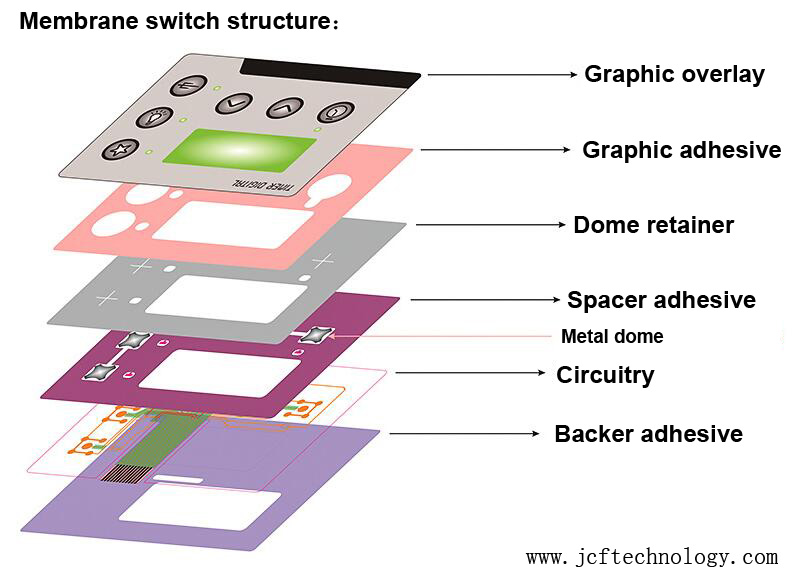Recognizing Membrane Changes: The Key to Trusted and durable Controls

What Are Membrane Layer Buttons?
Membrane layer buttons are a sophisticated service in the realm of individual interface modern technology, incorporating performance and style flawlessly. These tools function as an interface between users and electronic systems, integrating numerous components into a compact style. Commonly constructed from versatile, slim layers of materials, membrane layer buttons are designed to reply to touch, allowing customers to communicate with machinery and digital tools properly.
The key elements of a membrane layer switch consist of a published circuit layer, graphic overlay, and a spacer layer that protects against unexpected activation. The graphic overlay can be tailored to show brand name identification or user preferences, enhancing appearances while guaranteeing usability. Membrane layer switches are frequently made use of in numerous applications, consisting of medical gadgets, consumer electronics, and commercial tools, owing to their resilience and resistance to environmental factors such as dampness and dust.
One of the essential benefits of membrane layer buttons is their capacity to hold up against damage, making them ideal for high-traffic atmospheres. Furthermore, they are lightweight and call for minimal space, enabling for ingenious layouts in item development. In general, membrane switches over stand for a efficient and functional selection for contemporary digital interfaces, weding technology with user-centric style principles.
How Membrane Layer Switches Job
The procedure of membrane switches joints on a basic yet efficient system that equates customer input right into electronic signals. When a customer presses the switch, the leading layer warps, allowing a conductive aspect in the circuit layer to make call with a corresponding conductive pad on the bottom of the graphic overlay.
The layout of membrane layer switches can vary, however they usually incorporate domes or tactile aspects to supply responses to the user, enhancing the overall experience - membrane switch. The products made use of in membrane layer buttons, such as polyester or polycarbonate, add to their sturdiness and resistance to ecological aspects, consisting of dampness and dirt. Furthermore, the printed circuits are generally encapsulated, which safeguards them from deterioration in time.
Benefits of Membrane Switches

In addition, membrane switches are known for their sturdiness. Built from durable products, they are immune to dirt, dampness, and physical wear, which significantly extends their lifespan compared to conventional mechanical switches. This sturdiness makes them especially appropriate for high-traffic environments navigate here and applications requiring longevity.
An additional substantial advantage is the ease of cleaning and upkeep. The smooth surface area of membrane layer switches over decreases dirt build-up and is usually unsusceptible spills, making them excellent for setups that call for regular sanitization.
Additionally, membrane layer switches offer a streamlined account, bring about a thinner style that can be integrated into numerous tools without adding mass. This function not only boosts the visual charm but additionally adds to a much more ergonomic product layout.
Applications of Membrane Layer Switches
Versatile and straightforward, membrane buttons discover applications across a vast variety of industries, consisting of medical devices, customer electronics, and commercial devices. In the clinical area, these switches are indispensable to gadgets such as analysis devices, patient surveillance systems, and infusion pumps, where integrity and simplicity of cleaning are important. Their ability to withstand extreme environments and keep functionality makes them excellent for such applications.

In customer electronics, membrane layer buttons are utilized in items like microwaves, cleaning devices, and remotes - membrane switch. Their sleek style permits for intuitive interface, boosting the overall individual experience while supplying resilience and resistance to deterioration
Industrial devices likewise profits from membrane layer switches, particularly in control panels for equipment and automation systems. These buttons offer protection against dirt and dampness, ensuring consistent performance in difficult environments. Their personalized attributes permit manufacturers to tailor them to specific operational needs, enhancing efficiency and functionality.
Choosing the Right Membrane Switch
When selecting a membrane switch, it is important his response to think about various elements that influence efficiency and viability for details applications. The main factors to consider include environmental conditions, responsive responses, toughness, and style specs.
First, evaluate the operating environment; switches revealed to wetness, chemicals, or severe temperatures require specific products to make sure durability and functionality. Next off, examine the requirement for tactile responses. Depending upon user interaction, some applications might benefit from a responsive action to confirm activation, while others might like a non-tactile style for aesthetic factors.
Resilience is another critical variable; membrane buttons must be designed to hold up against regular use, effects, and abrasion. Guarantee the picked switch can sustain the expected lifecycle, specifically in high-usage situations.

Verdict
To conclude, membrane layer switches over function as vital elements in the style of resilient and trustworthy control systems throughout numerous industries. Their portable style, incorporated with robust construction and customizable attributes, improves customer interaction while ensuring long life popular settings. The convenience of membrane switches enables tailored options that meet certain functional requirements, enhancing their importance in contemporary technology. As industries remain to develop, the relevance of incorporating effective membrane switch remedies can not be overstated.
Membrane changes represent an important aspect of modern interface design, mixing capability with durability in various applications.Membrane buttons are an advanced option in the realm of individual interface technology, integrating functionality and layout effortlessly. Typically created from flexible, slim layers of materials, membrane layer buttons are created to react to touch, allowing individuals to connect with machinery and digital devices effectively.
The design of membrane layer switches can vary, but they commonly include domes or responsive components to supply comments to the individual, improving the overall experience.In conclusion, membrane switches over serve as important elements in the style of sturdy and reliable control systems throughout numerous markets.
Comments on “How Membrane Switch Technology is Revolutionizing User Interfaces”